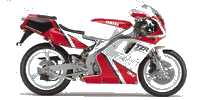What is the function off the valves on the 3MA.
The only function they have is to remove the remaining fuel that is left behind under the reed petals. (in the Low RPM)
In the lower RPM range the 3MA has trouble to clear it self from fuel particles that are swept up by the spinning crank on the lower reed stopper. There is is leaking itself to the frond of the reedblock where it stays and making the carbs richer and richer.
For this problem, Yamaha has mounted the one way valves.
You have two connections
1) The one way valve is located at the reedblock housing
2) The connection on the bottom off the crank case (normal working connector, not a one way valve)
1) The one way valve is located at the reedblock housing
2) The connection on the bottom off the crank case (normal working connector, not a one way valve)
How do they work.
Quit simple axially, They are connected from Left to right cylinder (crossed)
Meaning:
-Left one way valve is connected to the right crank case connection (bottom)
-Right one way valve is connected to the left crank case connection (bottom)
Just a starting point.
Left piston is going up, this creates a suction that goes from the left bottom connection to the right one way valve.
The suction allows the fuel to go trough the oneway valve into the bottom off the left crank cases.
Ones the piston goes down the suction stops and becomes a pressure.
This pressure goes trough the lower connection to the right valve but this time the valves stops the pressure because off the one way design.
Piston goes up again and etc etc.
On the 3MA1 Yamaha didn't know the in pact off the problem, and just designed the valve to work.
They placed it in the middle, to do its job
They placed it in the middle, to do its job
One the 3MA3 engine, Yamaha did know the impact of the one way valve and now they designed it completely different
They placed it to the right, and also made a gutter to its location, in the hope they work better.
They placed it to the right, and also made a gutter to its location, in the hope they work better.
Here we have the a one way valve, with his working
A suction on the connection is allowed, a pressure is blocked
A suction on the connection is allowed, a pressure is blocked
Have opened one to show its internals
Here is the hard off the construction, a small plastic (kinda) seal
It is locked in the brass construction where pressure is pushing it up and blocking the stream.
But when suction is there the seal drops and the stream can pass.
It is locked in the brass construction where pressure is pushing it up and blocking the stream.
But when suction is there the seal drops and the stream can pass.
Personally I'm a bid sceptical about this construction.
When you suck the remaining fuel from the (example) right side, it ends up on the bottom of the Left side where the spinning crank takes the fuel with him and smash it into its lower reed stopper where the same problem also is.
In small terms, you just pumping it around.
They also are limited by rpm, they only work in the lower RPM range (where the seal has time to close and open)
But what do they do in the higher RPM range, hover??
I wont say they are useless, but the efficiency off this designed is limited.



